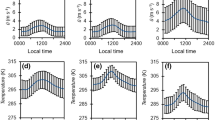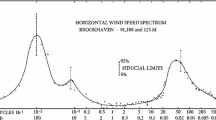Abstract
Long-term mean and turbulent wind data from four sites in Mexico were examined to understand the full-scale boundary layer wind spectrum for periods between 6 and 9 years. Spectral peaks were evident in 3 × 10–8 Hz (1 year), between 2 × 10–6 Hz and 3 × 10–6 Hz (3.9–5.7 days), and 1 × 10–5 Hz (1 day). Frontal systems (frequency ~ 6 days) were more commonly observed in winter. However, low-frequency maxima were associated with easterly waves during summer in southern Mexico. The daily peak was more intense than that observed in middle latitudes, suggesting thermal circulations and convective systems are the main weather systems in the summer. Downdrafts of convective systems caused wind ramp events in summer, lasting 1 to 6 h. Near-surface diurnal and sub-diurnal wind maxima decreased slightly with height. The spectral gap existed at frequency (f) range from 2 × 10–4 to 2 × 10–3 Hz and rapidly decreased with height. The spectrum of the observed wind speed S(f) at the high-frequency range of the daily peak (10–5 to 2 × 10–4 Hz) followed the f−5/3 curve. These results guide wind numerical prediction models, turbulence studies, and engineering applications. NOAA Rapid Refresh model had a steeper slope in the mesoscale range with ~ f−3 due to energy removal by the models associated with filtering and damping schemes, especially in the summer for the study region. Uncertainties on wind energy management and the implications of energy removal on wind ramp forecast distribution were discussed.
Access provided by Autonomous University of Puebla. Download conference paper PDF
Similar content being viewed by others
Keywords
1 Introduction
Wind energy is expected to become an essential component in the electrical portfolio. Wind energy can be forecasted by numerical weather prediction models (NWP). However, refinements are needed to improve wind forecast at heights of 50–200 m (Olson et al. 2019). Moreover, significant changes in wind speed over a short time interval (wind ramps) generate substantial changes in wind power output. Capturing these wind ramps by NWP depends on the appropriate modeling of weather systems. Wind forecasting over complex terrain is incredibly challenging due to the terrain-modulated flows (Olson et al. 2019; Siuta et al. 2017).
Spectral characteristics of horizontal wind speed are a theme commonly studied. The existence of the spectral gap has been broadly discussed (Larsén et al. 2016). The spectral gap allows for distinguishing large-scale atmospheric processes, mesoscale processes, and turbulence. Usually, the spectral peak observed at 12 h is less significant than the synoptic peak (Kang and Won 2016). The diurnal peak depends on location and season. It is relevant in coastal and mountainous sites.
This paper aims to examine the spectral structure of horizontal wind speed series for four masts under different weather systems’ influence in Mexico to gain insight into the atmospheric processes and extreme wind power ramps at the mast location. Also, the observed and forecast spectral structure of wind was compared using the NOAA/NCEP's Rapid Refresh Forecast System (Benjamin et al. 2016). This kind of study has not been done for subtropical-tropical regions, and model assessment allows for improving the physical parameterizations and post-processing output schemes.
2 Methods
The observational data used for this study are from two towers and two weather stations in Mexico for periods between 6 and 9 years. Their location is shown in Fig. 1. Wind speed and direction were recorded every 10 min.
Following the Fourier transform method, annual and seasonal spectra of wind speed were constructed to understand the weather system's role in local wind variability. The seasonal spectra were created by grouping the months corresponding to each year's season for the recording period. In this study, extreme wind ramps exceeded four times the normalized difference in wind speed during one hour.
3 Results
3.1 Wind Spectral Structure
Long-term mean wind and turbulence data are analyzed in this section. Spectral peaks were observed in 3 × 10–8 Hz (1 year), between 2 × 10–6 Hz and 3 × 10–6 Hz (3.9–5.7 days), and 1 × 10–5 Hz (1 day) (Pereyra-Castro and Caetano 2022). Near-surface diurnal and sub-diurnal wind maxima decreased slightly with height. The spectrum fell off the −2/3 slope for the four sites at frequencies higher than 8 × 10–5 Hz. Meanwhile, the yearly spectrum rose at f+1 from 10–7 to 10–6 Hz except for La Venta, Oaxaca.
The results show that low-frequency events (~6 days) were more common in winter (yellow and orange lines in Fig. 2) as a consequence of frontal systems passing over Mexico (Pereyra-Castro and Caetano 2022). These are the main middle latitudes synoptic modulators of winter weather. In summer, easterly waves produced low-frequency maxima in southern Mexico.
Seasonal smoothed frequency-weighted spectra fS(f) of horizontal wind speed for a Cabo San Lucas, b Ciudad Cuauhtemoc, c Francisco Villa, d La Venta. The solid black line corresponds to the slope f−2/3. The dotted black line represents the f+1 slope. JJA: June-July–August; DJF: December-January–February; MAM: March–April-May; SON: September–October-November (Pereyra-Castro and Caetano 2022)
Local circulations intensified as synoptic systems weakened from spring to summer. The thermal differences caused by the land surface heterogeneity produced local circulations between 8 and 12 h, manifesting as more evident daytime maxima in the summer period (Fig. 2). The spectral peak in 1 × 10–5 Hz was higher than the observed in middle latitudes (Pereyra-Castro and Caetano 2022).
3.2 Case Study: Ciudad Cuauhtemoc
Ciudad Cuauhtemoc is an example of weather systems influence methodology used for every site. For the 8-year data series, 10.25 wind ramps occurred in winter and 5.75 in the summer on average. Winter ramp-up persistence ranged from 1 to 30 h, suggesting the effect of large-scale systems as extratropical cyclones. Meanwhile, summer events lasted from 1 to 6 h, which could be associated with mesoscale events.
Cold fronts caused winter wind ramp events in Northern Mexico. Northerly cold fronts accelerate wind at the station, even if the cold front is located over eastern Mexico. As a result, wind power variability can be dominated by synoptic phenomena during the week, changing wind power generation. Energy increment (in the lower frequency side of the spectrum) is due to these systems from December to April.
Downdrafts of convective systems (forming in the Sierra Madre Occidental) mainly caused wind ramps in summer (Fig. 3a). These events are usually of short duration (< 3 h). Therefore, most of the daily precipitation occurred around the wind ramp timing. Also, trade wind intensification from the Gulf of Mexico contributed to wind ramps in Ciudad Cuauhtemoc during summer (not shown).
a Summer ramp-up event at Ciudad Cuauhtémoc (red circle). Surface wind speed and daily precipitation in mm (shaded); b The frequency-weighted spectra fS(f) of observed horizontal wind speed (gray) and RAP forecast (red) for 2013 at Ciudad Cuauhtemoc. The solid black line corresponds to the slope f−2/3. The dotted black line represents the f+1 slope
Figure 3b shows the frequency-weighted spectra of observed horizontal wind speed and RAP forecast for Ciudad Cuauhtemoc. On the high-frequency side of the diurnal peak, the spectrum fell following −2/3 dependence in frequency. The numerical model RAP showed a steeper slope of ~ −2, similar to those found by Larsén et al. (2012) for a coastal offshore site in Denmark. Numerical models underestimate wind ramp tails due to spatial and temporal smoothing; consequently, the energy is misrepresented at the mesoscale range.
4 Discussion
Improving the understanding of the full-scale boundary layer winds through analyzing the spectral structure and the weather systems modulation is essential for refining NWP models. Mexico, a tropical-subtropical region, experiences cold fronts in winter, which are the main modulators of wind variability at the low-frequency side of the diurnal peak. In summer, the representation of local circulations and mesoscale systems is fundamental for the adequate forecast of wind speed. For that reason, model enhancements must be done for summer conducive to a better forecast of wind ramp events, especially those of short duration. A correct prediction of wind variability could upgrade wind farm management and energy integration into the electrical system. The energy deficit can be corrected by considering the difference between the modeled and measured spectra in the high-frequency range, as suggested by Larsén et al. (2012).
5 Conclusion
The spectral structure of horizontal wind speed was influenced by weather system seasonality over Mexico. Middle latitude systems modulated the low-frequency side of the spectrum in winter. In contrast, mesoscale convective systems and thermal circulations were the main drivers of the high-frequency side of the spectrum during summer. Temporal and spatial smoothing of mesoscale models affected the tails of wind ramp distribution, especially in the summer, such as the wind forecast provided by the Rapid Refresh model.
References
Benjamin, S. G., et al. (2016). A North American hourly assimilation and model forecast cycle: The rapid refresh. Monthly Weather Review, 144, 1669–1694.
Kang, S.-L., & Won, H. (2016). Spectral structure of 5 year time series of horizontal wind speed at the Boulder Atmospheric Observatory. Journal of Geophysical Research: Atmospheres, 121, 11946–11967.
Larsén, X. G., Larsen, S. E., & Petersen, E. L. (2016). Full-scale spectrum of boundary-layer winds. Boundary-Layer Meteorology, 159, 349–371.
Larsén, X. G., Ott, S., Badger, J., Hahmann, A. N., & Mann, J. (2012). Recipes for correcting the impact of effective mesoscale resolution on the estimation of extreme winds. Journal of Applied Meteorology and Climatology, 51, 521–533.
Olson, J. B., et al. (2019). Improving wind energy forecasting through numerical weather prediction model development. Bulletin of the American Meteorological Society, 100, 2201–2220.
Pereyra-Castro, K., & Caetano, E. (2022). Wind-ramp predictability. Atmosphere, 13, 453.
Siuta, D., West, G., & Stull, R. (2017). WRF hub-height wind forecast sensitivity to PBL scheme, grid length, and initial condition choice in complex terrain. Weather and Forecasting, 32, 493–509.
Author information
Authors and Affiliations
Corresponding author
Editor information
Editors and Affiliations
Rights and permissions
Copyright information
© 2023 The Author(s), under exclusive license to Springer Nature Switzerland AG
About this paper
Cite this paper
Pereyra-Castro, K., Caetano, E., Miranda-Miranda, U. (2023). Analysis of Wind Speed Series at Four Sites in Mexico. In: Chenchouni, H., et al. Recent Research on Hydrogeology, Geoecology and Atmospheric Sciences . MedGU 2021. Advances in Science, Technology & Innovation. Springer, Cham. https://doi.org/10.1007/978-3-031-43169-2_57
Download citation
DOI: https://doi.org/10.1007/978-3-031-43169-2_57
Published:
Publisher Name: Springer, Cham
Print ISBN: 978-3-031-43168-5
Online ISBN: 978-3-031-43169-2
eBook Packages: Earth and Environmental ScienceEarth and Environmental Science (R0)







